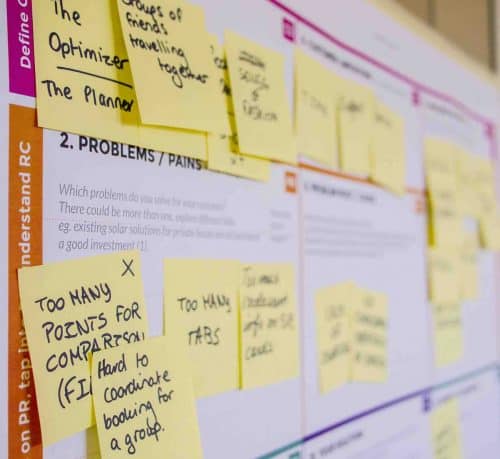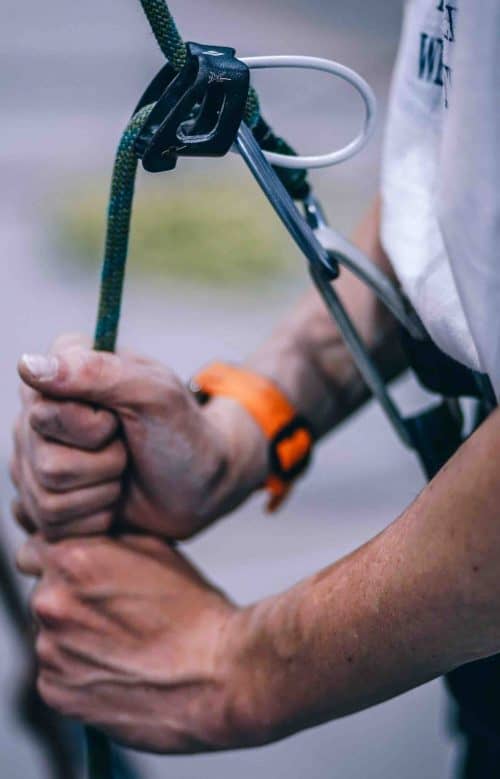What is anxiety?
Feeling anxious in certain situations can help us avoid danger, triggering our ‘fight or flight’ response for survival. It is how we’ve evolved to keep ourselves safe. However, there are times where we become overly worried about perceived threats – when things that may or may not happen affect us on an emotional level. When your worries are persistent or out of proportion to the reality of the threat, and get in the way of you living your life, you may have an anxiety disorder (Black Dog).

The American Psychological Association (APA) defines anxiety as “an emotion characterized by feelings of tension, worried thoughts and physical changes like increased blood pressure”.
When our anxiety levels are heightened, we have intense feelings of worry or distress that are not easy to control. Anxiety can interfere with how we go about our everyday lives, and make it hard to cope with ‘normal’ challenges. These ‘bouts’ or ‘intense periods’ can be a result of a multitude of scenarios that contribute to anxiety. Two of the most notable scenarios are workload stress, and social anxiety.
Anxiety is the most common mental health condition in Australia. Up to one-third of women and one-fifth of men will experience anxiety at some point in their lives (Beyond Blue).
The type of anxiety that occurs before a presentation, playing in a big sporting event, starting a new job, or doing exams at school, are not what is being referred to above.
Usually, once we’ve overcome a stressful situation, our worries and nervous feelings calm down and disappear. But, what if this worry stays with us even after a stressful situation has passed?
Fear, distress and feelings of dread can take over. We can experience severe anxiety that can last for a long time. When we have this level of anxiety, we might start to worry about things that others don’t find stressful. But we might not realise that anxiety is taking control of our everyday lives.
This is why it is important to know how to recognise signs of anxiety in yourself or a loved one.
What causes anxiety disorders?
Anxiety disorders are thought to be caused by a combination of factors. Most people who get anxiety probably possess a genetic vulnerability to develop an anxiety disorder. This can be innate in an individual’s personality traits, meaning that responses to stressful life events may trigger the condition or make it worse. This is why it is important to identify, prepare and confront your anxiety in order to take progressive steps to recovery.

The triggers of anxiety vary from person to person, and are often the cause of a particular past life event. These common stressful life events include:
Being in an unpredictable new situation such as a change of school or workplace, or travelling overseas.
Break-up of a relationship.
Experiencing the death of somebody close.
Financial or work problems.
Experiences during early childhood.
Excessive drug or alcohol use.
Physical health problems.
When the initial incident of occurs, it can express itself physically as well as psychologically, and also affect behaviour. Recognising this behaviour is the key to realising anxiety symptoms within yourself or someone you know.
These changes in how someone feels, thinks, and acts can then start to interfere with their ability to live a normal life, to work, and to relate to other people (SANE).
To find out more about the broad symptoms of mental health and how they affect individuals differently, see our comprehensive: Guide to Mental Health.
How do I know if myself or someone I know has Anxiety Disorder?

It’s understandable that people will change their behaviour to try to avoid distressing symptoms of Anxiety disorders. This can result in an individual not doing the following: identifying the root cause of their anxiety, preparing by seeking help, or confronting their anxiety through regular and habitual development.
It is this reluctance to participate in any of the above steps that can compound an individual’s symptoms – whether they be your own or present in someone that you know. To be aware of these symptoms is to initially watch out for the physical signs associated with anxiety. Following deeper inquisition of how you or the other person are feeling, and what they might be experiencing, will sometimes then alert you to their deeper thoughts.
Those with Social anxiety disorder, for example, will avoid situations where other people are present. This can lead to an absent social life, experiencing great loneliness, and even stopping them from working. Because if this, anxiety disorders are often accompanied by Depression. This means both will need to be treated when the individual takes preventative steps to recovery (our detailed breakdown of Depression can be found here).
Below is the anxiety experience of one of our clients at Palladium Private.
Sam’s struggles and progress during his anxiety allude to the three steps mentioned previously – with emphasis on how he managed each step.
While each individual is different, his anxiety might be similar to what you or someone you know is experiencing at the moment. If so, the process that he undertook could work for you as a guideline to recovery.
In his best online anxiety courses, Dr. Rick Hanson emphasises the importance of confronting anxiety rather than avoiding it. He suggests that avoiding anxiety-inducing situations only strengthens anxiety in the long term. By gradually exposing themselves to these triggers and practicing mindfulness, individuals can rewire their responses to anxiety, reducing its power. Dr. Hanson also stresses the value of emotional resilience and seeking support to manage anxiety effectively. These techniques aim to create lasting change by addressing both the emotional and neurological aspects of anxiety.
An interview with someone who has anxiety
It’s understandable that people will change their behaviour to try to avoid distressing symptoms of Anxiety disorders. This can result in an individual not doing the following: identifying the root cause of their anxiety, preparing by seeking help, or confronting their anxiety through regular and habitual development.
It is this reluctance to participate in any of the above steps that can compound an individual’s symptoms – whether they be your own or present in someone that you know. To be aware of these symptoms is to initially watch out for the physical signs associated with anxiety. Following deeper inquisition of how you or the other person are feeling, and what they might be experiencing, will sometimes then alert you to their deeper thoughts.
Those with Social anxiety disorder, for example, will avoid situations where other people are present. This can lead to an absent social life, experiencing great loneliness, and even stopping them from working. Because if this, anxiety disorders are often accompanied by Depression. This means both will need to be treated when the individual takes preventative steps to recovery (our detailed breakdown of Depression can be found here).
Below is the anxiety experience of one of our clients at Palladium Private.
Sam’s struggles and progress during his anxiety allude to the three steps mentioned previously – with emphasis on how he managed each step.
While each individual is different, his anxiety might be similar to what you or someone you know is experiencing at the moment. If so, the process that he undertook could work for you as a guideline to recovery.

How long ago were you at Palladium?
“In October 2018, so about 5 months ago now.”
How are you feeling now?
“I’m going good, just a couple rough days here and there, but overall at about 95%.”
And what are you doing now?
“I’m in Brisbane at the moment. Not long after I got out of Palladium, I got offered a job up in the National Parks in Clairemont since January.”
To get an idea of the start of your journey, how would you describe your state of mind, mentality or emotions – a year or a few months before the retreat?
“I struggled with my mental health for over 10 years. It got to the point where, leading up to Palladium I tried to kill myself a couple times. A week before I got into Palladium, I tried again – and that’s what pushed my family to look at options for my mental health, and that’s where Palladium came into play.”
What was the process like for you at Palladium?
“I was given a few places to decide between. But chose Palladium for the simple fact that they offered the group therapy every afternoon. For someone like me, who actually struggled with people and talking to people, it was because of the communication group and the individual therapy that I chose Palladium.”
Was that because of the Anxiety – interacting with people every day, and needing to re-introducing yourself to communal environments?
“My self-esteem was the biggest issue actually. And I do like people, but I still just struggled to have a conversation, and talk to people in that aspect. I would stop putting myself out there in that environment, so that struggle wouldn’t come up again.”
When you realised this, who was it that contacted Palladium?
“It was a family member first – my brother’s partner that got in touch. At that time, I shut down completely – I was in my room for 12 hours a day or in and out of hospitals, so I really couldn’t function well enough to be able to make that decision on my own.”
So to re-kindle your communication with others, was there anything aside from the group therapy that you feel helped you?
“For sure. I found all the team there to be top notch. Carmel the massage therapist was incredible, so to was Pat, I was quite sad to see him go when he left – mainly because we got along really well. I got along with all of the chefs as well, plus Stacey and also Nicole were great helps throughout the whole thing. I have actually seen Carmel since leaving for a remedial massage – she was a therapist on her own.
There wasn’t a staff member that I didn’t enjoy being around. Even Shaun the groundskeeper, I had many chats with and enjoyed his company.”
Aside from the communications groups and the staff, were there any therapies, that you found challenging?
“I found, in all of the activities that were offered, I didn’t want to go to art therapy at the start. But I did push myself, and actually got a lot out of it – which I found really helpful to me to express how I was feeling in a different way, a more creative way.
Once you’re in there, you can actually go quite deep. Which is what I found hard at first was that I couldn’t draw, and everyone else could really well. As soon as I let go of that fear of being good enough, you start to become more involved and take something from the activity”.
And from when you started, how long did it take for you to feel more comfortable?
“Probably the second day I was still apprehensible of being there in a totally different environment – but even after the first couple hours I was starting to acclimatise. Trying to join in with things that I was comfortable with – but also taking time to roam a little because when I was young I liked the outdoors.”
Did the staff or seeing other people in a similar place to you have an effect on how long this took?
“yep, to help me feel safe, and to push myself. I knew everyone was there for similar, but different reasons. Which is very likely going into that environment – and made it a lot easier, because of the community.”

Were there any major experiences or learnings that you took away from the Retreat, or occurred while you were there – namely through your sessions or personal treatments?
“Lisa was my therapist, and was an amazing help throughout the whole process. She was great for finally helping me talk about all those 10 years that had happened before the retreat.”
Have you finished all of your calls with Lisa?
“I’ve finished all of my after-care as of now. I would go back and see Lisa, but I just can’t afford it at the moment – I’d love to see her on a weekly basis but finances won’t allow that.”
That’s a really good point you make, which is why we’re doing this – to make all the Palladium content more accessible through the content that we are doing. Were there any exercises that you did with Lisa that helped you the most?
“I’d have to say the overall experience that I had with her, and just how she listened and was there as a helper. I’ve been to many psychologists over my years – and just going in to see how she operated, was good at the start because I had experienced that before. But until I let go and put my trust into her it was, the way that she listened and her as a person that made my stay that much more worthwhile.”
How did you find getting back to your life outside of Palladium in reference to the tools that you took with you etc.?
“That’s something that I feel Palladium should put more emphasis on. Actually leaving Palladium after four weeks, because there wasn’t as many tools by way of integrating back into a normal lifestyle, where there are all of these triggers around.
I got home and I didn’t watch TV for two and a half weeks, because I couldn’t watch it after being at Palladium where TV wasn’t accessible. Which wasn’t bad in any way, actually more good than bad, but I don’t think I was ready to either.”
Do you think then, in ways of tools, that worksheets or reminders here and there would work?
“I wouldn’t involve the people that had just gotten there, but for the people that have been at the Retreat, I’d start involving some sort of program in terms of their daily activities. Where they are informed that they will be leaving, and these are certain things that they are going to experience going back.”
That’s really good to know. Thank you. Since leaving Palladium and your first few weeks at home, how have you found the last few months? Do you do set reminders, or do daily check ins with yourself?
“I got into a book by Eckhart Tolle He’s a legend, and his book, The Power of Now, is by my bedside, and I’ve pretty much been reading him every chance I get.
“But also a lot of mindfulness and sitting by myself and meditating. Just paying attention to living in the now. And that’s one thing that I really took on board with my stay is that I can’t change my past, and I shouldn’t want to either.”
Do you feel that once situations arise, pertaining to your previous anxiety, do you handle them differently?
“Definitely. I used to struggle with my anger, had really bad anger problems. I made the staff at palladium fully aware of my anger problems, and I wouldn’t take anybody’s behaviour, and I would lash out and deal with it the way I have always known.
And have been around people that have pushed my buttons so to speak – understanding that they’re just making my ego upset and not me as a person. And I have started to take a step back and take a different perspective.”
Do you still have any anxieties or issues communicating?
“I’ve had a lot of anxiety since I’ve been in Clairmont, and having people around me which has been really tough. In a way I have felt that I’ve lost a bit of what I have learnt from Palladium since I’ve been here. But I am doing pretty good considering.”
How does your family feel?
“Some of my family members are never going to change. I’ve put somethings in place for them. This has been a bit difficult. I’m living my life not to someone else’s expectations. That’s the toughest thing about going back to certain family members that trigger you. And it’s hard to reframe them because they are your family members.
Which is why it is important I understand that some people aren’t able to understand, because they haven’t been through what I have been through – and that’s ok. I just don’t speak and don’t action what I used to because It’s falling on deaf ears now.”
Anxiety disorders are treatable
Treatment for an anxiety disorder doesn’t just deal with immediate symptoms. It also helps tackle the triggers for symptoms and other contributing factors. To reduce or eliminate anxiety, learn to control it with practical steps you find work for you. With the right process for you, you will feel better mentally, emotionally, and physically.
Reducing anxiety in your life
There are lots of things you can do for yourself to help reduce feelings of stress and anxiety. These could involve picking up a book like Sam, or even getting physical exercise.
The experience of having an Anxiety disorder varies from person to person. Managing symptoms can often be difficult, to help this – discuss with your treating health professional what you can do to help yourself. This will help you learn like Sam, what works and what doesn’t.
Understanding is power
The more we understand about Anxiety disorders, the better prepared we are to start dealing with them. Understanding the symptoms, causes, and symptoms of anxiety can help us to tackle it better. This is what we aim to achieve at Palladium to help equip our guests with the right mindset to learn about their condition.
Learning to tolerate uncertainty
Many anxious people feel a strong need to ‘know for sure’ about situations or about the future. This often just isn’t possible.
Do what you can to accept that things often are uncertain, and to ‘wait and see’ – to embrace the uncertainty of the future is hard, but it starts with accepting your past.
Mutual support

Many people affected by Anxiety disorders find it helpful to meet and talk with others who have had similar experiences.
Discussing symptoms and tips for dealing with them in a relaxed, understanding environment such as this can be a great support in recovery from anxiety.
You can contact the SANE hotline at 1800 18 SANE (7263) or the SANE Online Helpline for details of a group in your area, or take the Black Dog online Anxiety Self-test.
Learn to recognise the warning signs
Learn to recognise the warning signs, so you can re-assess your situation and try to nip the anxiety in the bud – much like Sam when reassessing situations from a different perspective.
Think about what happens when you start to feel anxious. If you often feel like you are going to have a panic attack on public transport, for example, make a list of how you feel and what happens to your body when this happens.
Alongside this, make a list of how you could manage these symptoms – such as slow breathing or thinking about something very positive, for example (Black Dog).

Build on what you know helps
You probably already have some healthy ways of helping yourself feel less anxious. Recognise and build on these.
Every time you worry over a past event that might reoccur in the future, stop and focus on the here-and-now. Immerse yourself in the moment.
Some people find it helpful to have a mantra (a helpful, inspiring phrase) or powerful mental image to help them do this: for example, imagining their life as a vast sphere and the worry as a tiny speck beside it.
Break problems down to tackle them
When you feel anxious it can seem like there’s no way out from problems that trouble you. Try to take a fresh approach which helps you look at the problem from a different angle, so that stress and worry can be reduced.
If something is troubling you, try not to dwell on it but write it down in black-and-white. Then write down all the different ways you could tackle it.
Consider which is the most realistic and useful, and what practical steps you could take to carry it out.

Slow breathing
It’s likely your GP, psychologist or other treating professional will talk to you about breathing slowly as a way of dealing with anxiety.
This can be a surprisingly simple and effective way of helping your body relax and switch off the tense ‘flight or fight’ emergency response which anxiety triggers.
Take a slow breath in for six seconds, hold it briefly, then breathe out slowly. Don’t rush the breaths, and repeat for a minute or so (SANE).
Being physically healthy is good for our mental health
Being physically healthy is good for our mental health
Our physical and mental health interact continually. Getting enough sleep, eating healthy meals, and avoiding recreational drugs and excessive alcohol not only does your body good, but will make you feel good too.
Too much caffeine can contribute to feeling anxious, so try reducing or even giving up coffee or other drinks which contain caffeine.
Physical exercise is also a proven way of improving mood, probably because of healthy changes this brings about in the body and brain. This doesn’t have to mean going to a gym, but can be something as simple as riding a bicycle to work or taking a brisk walk for half-an-hour or more a few times a week.
Our physical and mental health interact continually. Getting enough sleep, eating healthy meals, and avoiding recreational drugs and excessive alcohol not only does your body good, but will make you feel good too.
Too much caffeine can contribute to feeling anxious, so try reducing or even giving up coffee or other drinks which contain caffeine.
Physical exercise is also a proven way of improving mood, probably because of healthy changes this brings about in the body and brain. This doesn’t have to mean going to a gym, but can be something as simple as riding a bicycle to work or taking a brisk walk for half-an-hour or more a few times a week.
Make time to relax and think

Make time every week to do things you enjoy and which relax you. Going for a walk, meditating during your lunch break, having a massage, listening to music or simply immersing yourself in reading or watching a movie can help calm you and reduce anxiety.
People affected by Anxiety disorders are often hyper-alert a lot of the time, so it’s good to deliberately tell yourself that your mind and body are ‘off duty’ and have a right to relax.
Don’t be too hard on yourself or others
Try to develop a habit of being flexible rather than over-demanding on yourself or others. Don’t try too hard to be perfect in everything you do – instead take a step back and try to see things from their point of view and why they might be acting the way they do.
Remember that you’ll never be able to control everything that happens around you, or what other people do and think, so why not accept this and concentrate on enjoying just being yourself.



